Mushroom flavored soy sauces are something you'll see often if you shop at Asian markets. It's a delicious twist on regular soy sauce you'll love if you like mushrooms, and it's easy to make at home. If you're a mushroom hunter, you'll have access to many more varieties than others.
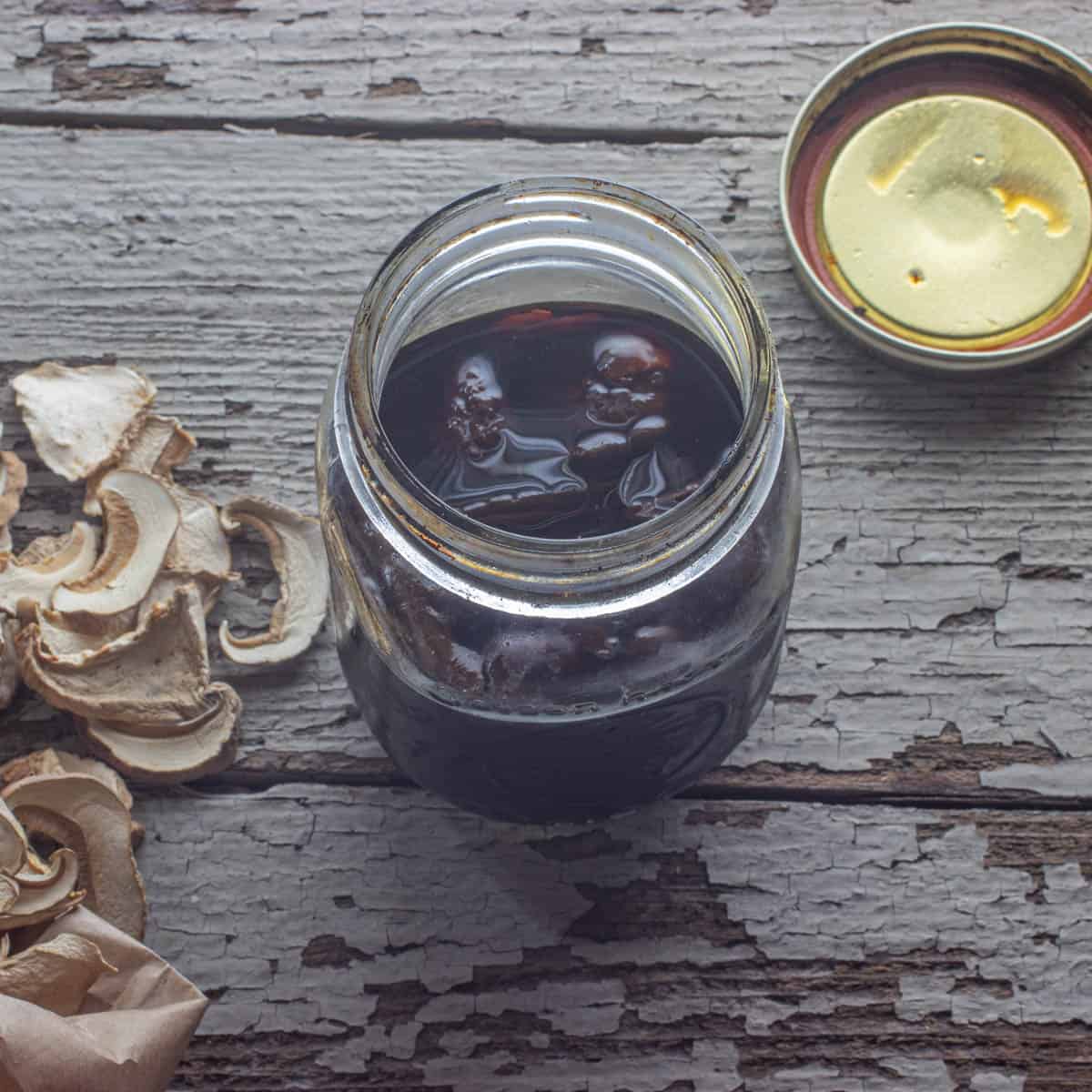
Mushroom infused soy sauce, especially the dark soy sauce versions will have a strong It's a strong flavor. It's good to use with a light hand.
How to make it
It's easy to make. All you need are some dried mushrooms, and a bottle of your favorite soy sauce.
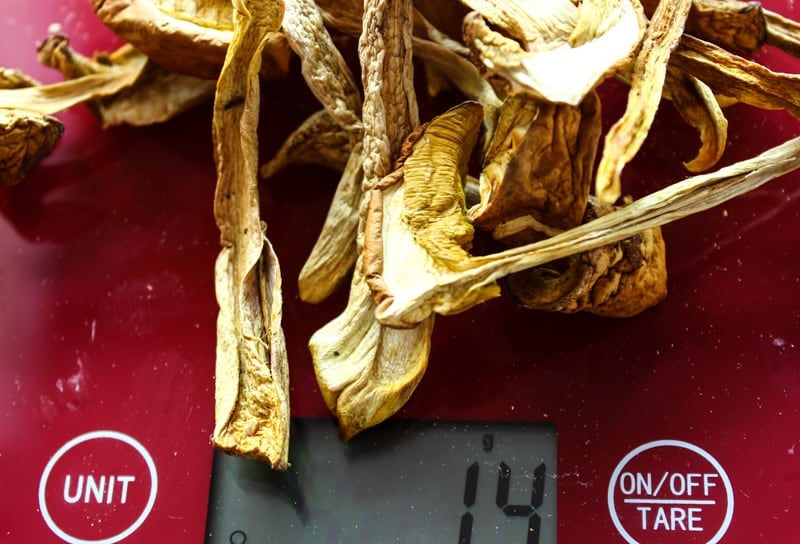
Fill a quart mason jar with dried mushrooms, cover them with soy. Put on a lid, let the mixture sit at room temperature for a couple weeks, then strain and keep in the refrigerator for the best flavor.
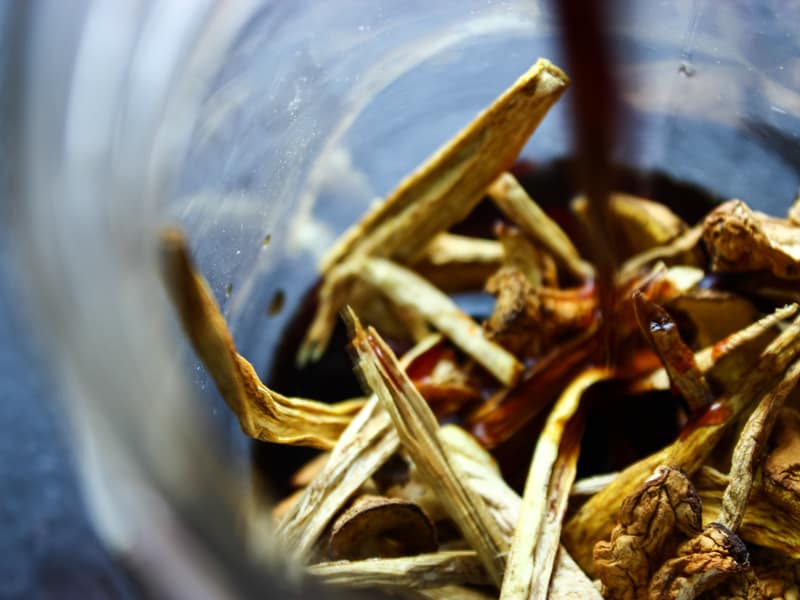
Mushrooms to use
This is a great way to use a variety of dried mushrooms. While dried porcini will give the strongest result, boletes that many people call "subpar" or lackluster when cooked fresh will taste better after a round in the dehydrator. Leccinum species and chicken fat boletes (slippery jacks) are great examples of this. Dried black trumpet mushrooms make a great version too.
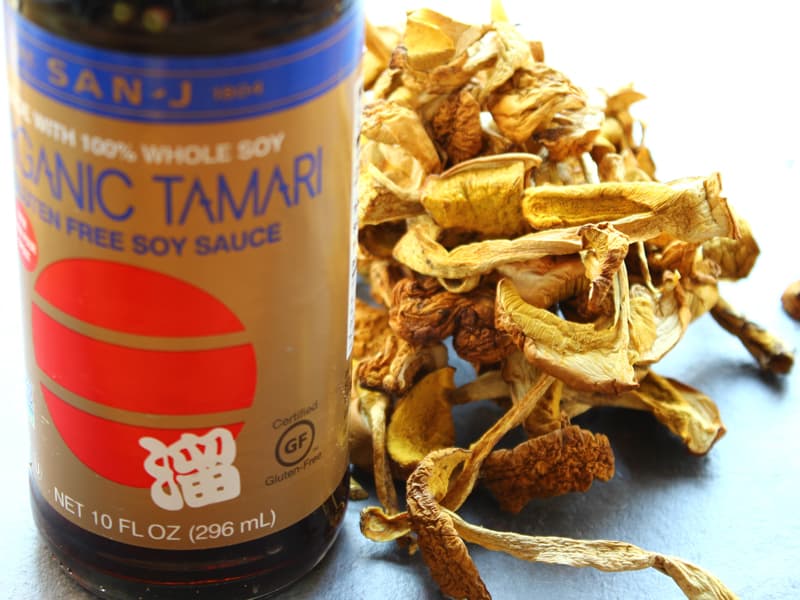
How to use
Use the mushroom soy sauce in any recipe that calls for soy. I love using it as the base of a Japanese dipping sauce mixed with mirin, and as a marinade. It's also fantastic used to season ramen or other brothy noodles. I'm sure you can find interesting things to do with it.
What to do with the leftover dried mushrooms
If you're a mushroom hunter you probably have plenty of dried mushrooms to use up. If you're not, you might be wondering what, if anything you can do with the mushrooms left over from infusing the soy. If you like, you can dehydrate the mushrooms and use them as a seasoning.
Dried Bolete Soy Sauce
Equipment
- 1 Pint mason jar
Ingredients
- ½ ounce dried Bolete or Russula mushrooms
- 1 ten ounce jar of soy sauce
Instructions
- Combine the dried boletes and soy sauce in small pot, bring to a simmer, then cool and store in an airtight container such as a pint mason jar.
- Store the jar in the refrigerator and allow it to age for a few at least 30 days before using. Remove the mushrooms, squeezing out any soy into a bowl to add back to the jar. Use the mushroom soy anyway you would regular soy sauce.
Notes
Nutrition
.

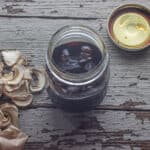
Sam
OK, I just posted about this blog entry on MushroomTalk. Any9one, member or not, may access the conversation via this link:
https://groups.yahoo.com/neo/groups/mushroomtalk/conversations/messages/21645
Alan, I look fwd. to your participation there and hope you'll have more insights in to Russulas after doing so.
Sam Schaperow, M.S.
http://tech.groups.yahoo.com/group/PlantForagers
http://tech.groups.yahoo.com/group/MushroomTalk
Sam
Hi Alan:
I know that I'm very pro-MT (was so even before I was made co-moderator), but my suggestion to discuss it there holds a lot of weight, even w/how your article looks today (there's still info. here that may not be entirely accurate, which I think you'd be helped with via such a forum-based discussion). But, before investing the effort to start that discussion, I want to know that you would be interested in learning what will be explained there, while some there will likely learn some things you've explained). So, just give me a go, and I'll start the thread.
Sam Schaperow, M.S.
http://tech.groups.yahoo.com/group/PlantForagers
http://tech.groups.yahoo.com/group/MushroomTalk
Alan Bergo
Ok Sam, that sounds fine. I understand that the "dry and smell" method was not entirely scientific, but I have been told of much less cautionary methods for russula consumption I.E. picking every species of russula one can find, boiling them in salt water and consuming. My Eastern European fried from Georgia does this on a regular basis, and says he has never become sick. I find the method interesting, but disregard it since the identity of individual species will be lost. Any way, sure, lets start a thread, if you think I can improve something on here that would be great. I appreciate your efforts, and patience with my occasional "noobism" :). Why don't you send me an email with links to the discussion, I will be away from the comp for the next two days.
Simon
Hey Alan. Thank you for the inspiration to use dried mushrooms. I love mushroom soy! Can the mushroom infused soy be used "raw" or do you have to heat it up before using it in cold dishes?
Alan Bergo
Hi Simon. So, mushrooms are essentially cooked by the dehydration process. It's a technique I use to make some species that could be problematic raw easily digestible. Leccinum are a good example. There is no need to heat the soy before using. Have fun.
Sam
Hi Alan:
I find this to be a particularly interesting article (blog post) that helps a forager to make *good use* of mushrooms they might otherwise not see as very valuable. But, there are a good number of points you brought up that you'd probably find helpful to understand about some of the concepts you brought up, which would best be discussed in a forum. I propose that you, I, and others discuss those points at MushroomTalk, then if you'd like to append to this post, or quote anything, or link to anything, then I think we'll be able to maximize the value of this very interesting article. If you agree, just give the word and I'll explain the subject there. (BTW, the other post you just did w/the shrimp stock was interesting to the point that I forwarded it to both forums in my sig; I hope others will spread the word of your excellent blog posts, which I find to be the best foraging blog anywhere).
Sam Schaperow, M.S.
http://tech.groups.yahoo.com/group/PlantForagers
http://tech.groups.yahoo.com/group/MushroomTalk
Alan Bergo
Hey Sam! So I have this habit of getting off topic in posts occasionally. Also seems like some people think I'm a bit nuts for the russula bit, but until I find a species that doesn't obey the dry and sniff experimental technique, I will keep doing it. Until I can really articulate individual species of russula, I've removed the tangent to keep the post more succinct.
BK
Oh, I wish your original "tangent" on Russula was preserved here. I am sure it would be valuable.